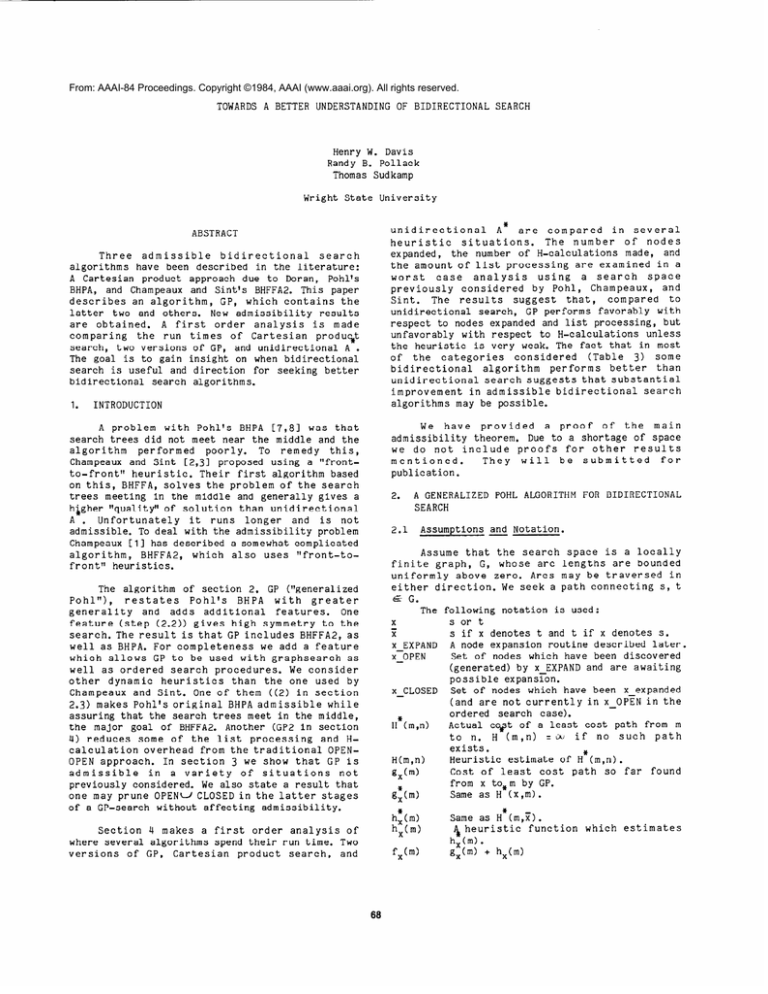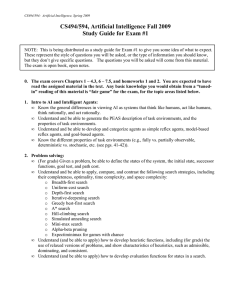
From: AAAI-84 Proceedings. Copyright ©1984, AAAI (www.aaai.org). All rights reserved.
TOWARDS A BETTER UNDERSTANDING OF BIDIRECTIONAL SEARCH
Henry W. Davis
Randy B. Pollack
Thomas Sudkamp
Wright State University
ABSTRACT
Three admissible
bidirectional
search
algorithms have been described in the literature:
A Cartesian product approach due to Doran, Pohl's
BHPA, and Champeaux and Sint's BHFFA2. This paper
describes an algorithm, GP, which contains the
latter two and others. New admissibility results
are obtained. A first order analysis is made
comparing the run times of Cartesian produc$
search, two versions of GP, and unidirectional A .
The goal is to gain insight on when bidirectional
search is useful and direction for seeking better
bidirectional search algorithms.
1.
INTRODUCTION
A problem with Pohl's BHPA [7,8] was that
search trees did not meet near the middle and the
algorithm performed poorly. To remedy this,
Champeaux and Sint [2,3] proposed using a "frontto-front" heuristic. Their first algorithm based
on this, BHFFA, solves the problem of the search
trees meeting in the middle and generally gives a
higher "quality" of solution than unidirectional
Unfortunately it runs longer and is not
A.
admissible. To deal with the admissibility problem
Champeaux Cl] has described a somewhat complicated
algorithm, BHFFA2, which also uses "front-tofront" heuristics.
The algorithm of section 2, GP ("generalized
Pohl"), restates
Pohl's BHPA with greater
generality and adds additional features. One
feature (step (2.2)) gives high symmetry to the
search. The result is that GP includes BHFFA2, as
well as BHPA. For completeness we add a feature
which allows GP to be used with graphsearch as
well as ordered search procedures. We consider
other dynamic heuristics than the one used by
Champeaux and Sint. One of them ((2) in section
2.3) makes Pohl's original BHPA admissible while
assuring that the search trees meet in the middle,
the major goal of BHFFA2. Another (GP2 in section
4) reduces some of the list processing and Hcalculation overhead from the traditional OPENOPEN approach. In section 3 we show that GP is
admissible
in a variety of situations
not
previously considered. We also state a result that
one may prune OPENU CLOSEDin the latter stages
of a GP-search without affecting admissibility.
Section 4 makes a first order analysis of
where several algorithms spend their run time. Two
versions of GP, Cartesian product search, and
i
unidirectional
A
are compared
in several
heuristic
situations.
The number
of nodes
expanded, the number of H-calculations made, and
the amount of list processing are examined in a
using a search
space
worst
case analysis
previously considered by Pohl, Champeaux, and
Sint. The results suggest that, compared to
unidirectional search, GP performs favorably with
respect to nodes expanded and list processing, but
unfavorably with respect to H-calculations unless
the heuristic is very weak. The fact that in most
of the categories considered (Table 3) some
bidirectional algorithm performs better than
unidirectional search suggests that substantial
improvement in admissible bidirectional search
algorithms may be possible.
We have provided
a proof of the main
admissibility theorem. Due to a shortage of space
we do not include proofs for other results
mentioned.
They will
be submitted
for
publication.
2.
2.1
A GENERALIZED POHL ALGORITHM FOR BIDIRECTIONAL
SEARCH
Assumptions and Notation.
Assume that the search space is a locally
finite graph, G, whose arc lengths are bounded
uniformly above zero. Arcs may be traversed in
either direction. We seek a path connecting s, t
& G.
The following notation is used:
X
s or t
F
s if x denotes t and t if x denotes s.
x EXPAND A node expansion routine described later.
x-OPEN
Set of nodes which have been discovered
(generated) by x EXPAND and are awaiting
possible expansron.
x- CLOSED Set of nodes which have been x-expanded
(and are not currently in X-OPEN in the
ordered search case).
Actual cogt of a least cost path from m
H*(m,n)
to n. H (m,n) =a~ if no such path
exists.
Heuristic estimate of H*(m,n).
H(m,n)
Cost of least cost path so far found
g,(m)
from x to,m by GP.
Same as H (x,m).
g:(m)
h*(m)
hi(m)
f,(m)
Same as H*(m,?).
sheuristic
function which estimates
h,(m).
g,(m) + hx(m>
c(p,m)
q
PTx(m)
AMIN
x- TESTi
2.2
(2 .4)
[This step is only needed if graphsearch
is being used] for each y& x TESTlA
!?TEST2-such that g,(y) has been lowered
ApIN&-- min(AMIN, g,(y) + g,(y)).
report the solution path
(3) If AMINdocl then
associated with the current AMIN; else report
failure.
Cost of a least cost arc from pto m in
G when such an arc exists. Assume c(p,m)
c(m,p>.
Parent of m with respect to a search
tree rooted at x.
Cost of least cost path between s, t
which
the algorithm
has so far
discovered. Initially AMIN = w .
x TESTi is one of the sets x OPEN,
X-CLOSED, x OPENLI x CLOSED, x CLOSED
u {xl, i=172. These-sets are used to
determine
when
to update
AMIN.
Admissibility
results
hold
for
different
combinations
of x- TESTi
values, i=1,2.
2.3 ---Special Cases of GP
To obtain Pohl's BHPA [7,81 set x TEST1 =
x CLOSED, x TEST2 = x CLOSEDUix),
omit steps
(2.2), (2.4)and use ordered search. The reason
x TEST2 must be x CLOSEDU 1x1 and not x CLOSED is
so that GP works-when it is run unidirectionally.
Pohl got around this by initially closing both
s,t. This technical alteration is the only way GP
differs from BHPA when steps (2.2), (2.4) are
omitted.
Pohl showe$ that when the h, are
optimistic (ie h, $ hx) BHPA is admissible. (In
F.81consistency is also assumed but C7;page 991,
points out that consistency is not required.)
GP
We use the
X-EXPAND a
For each
If
rn+
following node expansion routine:
node p& x-OPEN
neighbor m of p do
x-OPEN\> x_CLOSEythen
The Champeaux-Sint tlfront-to-frontll
heuristic
function is given by
(1)
h,(z) = min{H(z,y) +
gp(y): ye Y-OPEN].
To obtain BHFFA2 from GP one uses (1) and makes
appropriately
a number of the choices left
arbitrary in GP, namely:
(a> In (2.1) choose
x=s or t so as to avoid
expanding
a node from s OPENn
t OPEN
whenever possible.
lb) When in (2.1) GP is forced to expand a node w
G s-OPENP\t-OPEN
it chooses w to be that
node (or one of those nodes) in {y: yc
x OPEN, fx(y) is minimum) whose g,(w) + g,(w)
value is as small as possible.
cc> (2.4) is omitted and ordered search is used.
Champeaux's routines EXPAND1 and EXPAND2 are
(4
obtained in GP by performing steps (2.2a),
(2.2b), and (2.2~) whenever possible,
(e> Set x TESTi = x-CLOSED, i=1,2, x=s,t.
-~~?lYZg"(,,
+ c(p m>
x OPEN+
::OPENd &1
Ifi.
x OPfiti X-CLOSED with g,(p) +
c(p,m)< g7m) then
g (m)ulS g (p>
c(p,m>
+f (mkt:
IfXm & x CLOSED then 9-evitalize mtrvia
ordered-search
or graphsearch (see
below)
Remove p from x-OPEN
x-CLOSED+
x_CLOSEDU (~1
If ordered search is being used then llrevitalize
m I1 means
to place m into x OPEN.
In the
graphsearch case it means to recursively update
the gx and PT, values of all of m's G-neighbors
and whatever of their G-neighbors that have been
so far generated. See [6;2.2.21.
Algorithm GP
(1)
x-OPEN+
(x}, gx(x)Q- 0, PTx(x)+ x, x=s,t.
AMIN+&> .
(2) Do steps (2.1) through
(2.4) until either
(a) or (b) is true:
(a) x OPEN = 6, x=s or t.
(b) AqIN5 min Ifx(y): YE X-OPEN),
X=S or t
For x=s or t choose some w & x OPEN
(2.1)
such that fx(w) = min
{fx(yT:
y
E X-OPEN). X-EXPAND w. In steps (2.2)(2.4) x has the value assigned in this
step (s or t).
[This step is optional.] If ordered
(2.2)
search is being used then anFor all of
(a), (b), (c) below may be performed.
(b),(c)may be performed many times.
(a) If w E F OPEN then x EXPAND w.
(b)Anode
Tin x'?&Ejb
is removed
from ??CLOSEDand placed in T OPEN
provided that (within thissame
instance of the step 2 do-loop)
either g,(n) is lowered or n is
assigned its first glFValue.
(c) Same as (b) with x, x interchanged.
For each new member y& x_TESTlfljTTEST2
(2.3)
AMIN+
min(AMIN, g,(y) + g,(y)>. -
It is shown in Cl] that if H is optimistic
(2, Hs H ) then BHFFA2is admissible. It is not
hard to find examples of H being optimistic while
the heuristic function
h, -m
based on H (ie (1)
holds) is not optimistic. Interestingly there is a
simple "front-to-front" heuristic function which
is optimistic. Therefore it makes Pohl's BHPA
admissible while assuring that the search trees
meet in the middle. We show in an appendix that
when H is optimistic so is
(2) h,(z) =
min(H(z,y) + g?(y): Y G K-OPEN}
I- if z & Y-CLOSED
min{gz(z))W
IH(z,y) + g?(y):
1. y&;ji OPEN) otherwise
The definition
of equation
(1) can
extended as follows:
Let S(x)C x- OPENLIx - CLOSED, x=s,t. Define
be
(3)
hX S'H(z> = min(H(z,y) +
g;;(y):ye S(K)}
We call S(x) a -target set and say S is admissible
if GP has an admissibility theorem for h,SfH hen
H is optimistic, This does not imply that hx '9' is
69
be an optimal
path.
Not all the x are in
x CLOSED because otherwiseA
would hgve been
discovered (x=s,t): this is because (bl) assures
that at least ji& x_TESTlf? z-TEST2 so steps
(2.3), (2.4) would have foundp . Take j least and
k greatest such that x.f s-OPEN and xk& t OPEN.
j f- k because otherwi-de, by (b2), /o wouldhave
been discovered.
%ince x1 is s CLOSED for all
1 < j, g (X.) = g (x.) and siFilarly for xk.
Assuming 8(x-3= x-O?'ENjwe have fs(xj) = gs(xj) +
optimistic,
although
it may be. Pohl and
Champeaux, respectively, showed that {x1 and
x OPEN are admissible. Another admissible set is
S;-(x)= {x1U x-CLOSED; in fact, for this S, h S#H
is optimistic (see appendix). An advantagz of
Sl(x) over x OPEN is that it's smaller.
The
problem with such a relatively static non-frontal
target set is that H-calculations may become fixed
to an interior node (eg, s or t) which erroneously
looks close to the opposite front due to an unseen
hill. S2(x) = {PTx(y): y& x-OPEN1 is smaller than
Sl(x) and doesn't have the interior node problem.
It is admissible. One may extend the notion of
target set to allow dependence on two variables
and, thereby, incorporate (2) into (3). Let
i OPEN if z$ F CLOSED
{?,c/ ? OPEN otherwise
Then S is admissible: Replacing S(x) in (3) with
S(j;,z)gives (2).
S(j;,zi=
3.
3.1
hs(Xj) C
go
+ H(xj, 'k) + gt(xk) C
go
+
H*b
x > + g,i(x ) = L. The argument for S(x) =
instead of xk if
(PT ?;) k yc x-0 b EN) uses x
The argument for ft !z'similar.
r
t.
'k
(
Now assume (iia). The reason we don't need
(bl) to assure that not all x QJJ are x CLOSED is
that, due to GP's step (2.2a)q if x'werex CLOSED
it would also be x' CLOSED causing,/to
be
discovered in step (2.3).
The reason' we don't
need (b2) to assure that j ,C k is that steps
(2.2a), (2.2b), (2.2c), together, assure us that
x OPEN.0 x' CLOSED =,K The rest of (iia) is like
(Eb). The-completes the lemma's proof.
ADMISSIBILITY
Admissibility Theorem.
To prove the admissibility theorem for GP we
must eliminate the three cases mentioned above.
Cases (1) and (2) are handled as in the proof of
theorem 1 in Cl]. To dispose of case (3) we must
show that it is impossible for GP to halt with a
non-optimal
solution. Suppose that, on the
contrary, GP halts with a path of cost L'> L.
Then AMIN=L'. GP has not found a path of cost less
than L' because otherwise AMIN would be less than
Lt and the corresponding path would be reported in
step (3). But then, by the lemma, when GP finished
its last outer loop there were nodes m(x)& x OPEN
satisfying fx(m(x))5Lc:Lt = AMIN, x=s,t. This is
impossible because then the halting condition at
step (2) could not be triggered. Thus case (3) is
impossible. This completes the admissibility
proof.
Theorem GP is admissible is either (i) or (ii)
hold:
(i) h, is optimistic and x-TEST2 f x-CLOSED, x=s,
t (~0;l&pPA).
(ii) h
is given by (3) in section 2.3; H
ixS optimistic;
S(x) is either x OPEN or
IPTx(Y) : yc X-OPEN); and at leafi one of
(a) or (b) hold:
(a) Ordered search is
used and (2.2a),
(2.2b), (2.2~) of GP are
executed
whenever possible (Champeaux's BHFFA2).
(b) It is the case that
(bl) x TEST2 f x CLOSED, x=s,t, and
(b2) either x-TEST13 x-OPEN for x=s,t
or x-TEST23 x- OPEN for x = s,t.
3.2
The theorem may be proven by technical
modifications
of the original admissibility
arguments in [53, a testimony to the robustness of
those arguments.
One first proves the classical
"partial solution on open" lemma and uses it to
eliminate each of the following cases: (1) GP
never halts; (2) GP halts with no solution; and
(3) GP halts with a non-optimal solution.
We
prove here GP admissibility only for assumptions
(ii). Assumption (i) may be handled along the
lines of [7;pp 98 ff].
Admissible Pruning
The final GP search stage begins when some
solution is found, at which point AMIN becomes
finite. One may now prune x OPENU
x CLOSED
reducing target set sizes and the amount,f list
processing:
It can be shown
that,
under
assumptions (i) or (ii) of section 3.1, GP remains
admissible if (a) new nodes with f,-values >, AMIN
are not kept, and (b) old nodes with f -values
1
AMIN are removed from x- OPENux - CLOSE:.
4.
Lemma Assume (a) there is a path in G connecting
s,t; (b) GP has not yet found a minimal cost path;
(c) GP has just completed step(l) and zero or more
iterations of the outer loop. Then, if (i) or
(ii) holds, there are nodes m(x) 4 x OPEN such
that f,(m(x)) f L, where L is the cost of an
optimal path (x=s,t).
A FIRST ORDER COMPARISON
In order to get a first order comparison of
the total run time of several bidgectional search
algorithms and unidirectional A (UNI) the worst
case behavior of these algorithms was analyzed in
a particular
search space. The results are
summarized here. To a first approximation the run
time may be written as an expression of the form
* N + .3 H + r"L, where uc.,fl, r are problem
specific parameters, N is the number of nodes
Proof
We give the proof
for (ii) using
Champeaux's argument in [l;Lemma 11. Assume,
first, case (iib). Let// = (.3=x0,xl,...,xm = t)
70
expanded, H is the number of H-calculations
performed, and L is the total length of all lists
searched. For example, if H-calculations are cheap
while node expansion requires a lot of computer
time,theno( should be large andfl small.
Our
analysis focuses on the values of N, H, L for
several algorithms.
node is generated its H-values are calculated
against
the target
set S(x) = IPT,(y):
y
G
x OPEN). Suppose we change direction to ‘j7
and
mustlow obtain the new f-values for nodes on K
-OPEN. Instead of recalculating H(u,v) for all u
E F-OPEN, v& S(x), we update each hjl(u) with
respect to the new members of S(x) that were added
since we were last going this direction. The
effect is that hji(u) is being calculated with
respect to a target set larger than S(x), but this
does not effect admissibility. Old nodes have fvalues which are a little out-of-date but, if they
are erroneously expanded, the children will have
accurate information, hopefully preventing the
faulty behavior from continuing. The purpose of
this is to cut down on the list processing GPl
does to maintain its matrix of H-values.
The search space used was also studied by
Champeaux and Sint [31 and Pohl [7;Chapter 71, all
of whom calculated N for several algorithms: Let G
be an undirected graph containing a countable
collection of nodes; two nodes, s, t, have b edges
(b > 1) and there is a path of length K between
them. From all other nodes emanate b+l edges.
There are no cycles and all edge costs are one.
We have tabulated data about four algorithms:
UNI, X, GPl and GP2. X is a bidirectional search
obtained
by performing
UN1 on G x G. It is
apparently due to Doran
[43 and we use the
precise description found in C2;section 2.11. GPl
is a version of GP which uses ordered search,
skips steps (2.21, (2.4) and sets x TESTi =
We assume the front-to-front
x OPEN, i=1,2.
heuristic (1) of section 2.3 and alternating
direction. When direction is changed GPl never
recalculates H-values. Instead it searches a
matrix it maintains of relevant H-values. This
method was used in a program by Champeaux and Sint
[33. We assume that either H(u,v) = H(v,u) or, if
not, H returns both values.
Table 1 shows H, L values for the various
algorithms in terms of N. We have kept only the
highest order terms in N so the entries reflect
assymptotic behavior. The X entries are closely
related to the UN1 entries because X behave
essentially like UN1 with a branching factor of b,3
instead of b. The H(GP2) calculations were made
using a worst case assumption that
I{PTx(Y): Y
G x-OPEN11 = Ix-CLOSED). The smaller GP2 target
set unsurprisingly caused H(GP2) to be smaller
than H(GP1) by essentially a factor of b. The
casual update procedure for GP2 versus GPl reduces
the list processing from O(N3) to O(N2). While
these appear good, one must remember that one or
both may significantly reduce the heuristic power
of GP2 causing N(GP2) to be greater than N(GP1).
We have only begun empirical studies which would
reveal if this is true.
We include GP2 to illustrate what happens
when crucial changes are made in GPl. It is like
GPl except that a smaller target set is used and
it handles differently the problem of updating fvalues on OPEN when direction changes. When a new
TABLE
1
'1 GPl
v
(b2-b)N'/4
!
Perfect
TABLE
GP
K
2
X
K/2
UN1
K
Perfect
1 GP2
X
UN1
(2b-1>N2/4
b2N
bN
(b2+b-l)N2/2
(b4+b2-1)N2/2
(b2+b-1)N2/2
Knowledge
* H**/(~+s)
2b(K-l)S
-p
Kbr5
1
&K/2)-1
bK$
-2/4
(K/2)b16]
bK
bkb
-P
KbC6
bK
i
Knowledge
No Knowledge
H*?L 6
H**/(l+$
>
1
H*+ d
No Knowledge
TABLE
N
X<GP=UNI
GP<X<UNI
X<GP=UNI
GP<<X=UNI
3
H
UNIiX<<GP
X<UNI<<GP
ifS>\r27
X<UNI<<GP
GP<UNI<X
GP=UNI<X
GP<<UNI<X
UNI<X<<GP
if'i;<p
L
GP=UNI<X
X<UNI@S>
J
GP<UNI^Z>1/2
GP < X
71
Table 2 shows the value of N for different
algorithms and different heuristic situations. We
have kept only the highest order terms ialKK (gath
length). Also expressions of(,t_hle,forrn
b /(b -1)
have been approximated byb
. GP represents
either GPl or GP2 since both have the same N
values given our heuristic assumptions. Our
heuristic assumptions are as follows: &olumns 1,
respectively, assume perfect (H=H ) and no
4,
(HrO) heuristic information. (In the latter case
we assumed K even and that the solution is found
as late as possible.) Columns 2, 3 assume worst
case bounded errgr; column 2 is relative:
H(m,n) q
H (m,n)* (1+6), if both m, n
age on the solution path
H (m,n)/(l+ S), otherwise;
(
column 3 is absoAute:
H(m,n) =
H (m,n) + s , if both m, n
aie on the solution path
( H (m,n) - 5 , otherwise.
We assumes > 0, j3 = 6 (6+1)/(5+2), and CS 1 is
the integer part of 5 . We were surprised at how
closely all the algorithms performed except when
HE 0; in this case GP excells. We were also
surprised at the good performance of X.
BIBLIOGRAPHY
[ll
de Champeaux, D., Bidirectional heuristic
search again, J. ACM, Vol. 30, 1983 (22-32).
[2l de Champeaux, D., and Sint, L., An improved
bi-directional heuristic search algorithm,
IJCAI, 1975 (309-314).
de Champeaux, D., and Sint, L., An improved
[31
b&directional heuristic search algorithm, J.
ACM, Vol. 24, 1977, (177-191).
C41
Doran, J., Double tree searching and the
graph traverser, Res. Memo EPU-R-22, Dept. of
Machine
Intelligence
and Perception,
Edinburgh University, Scotland, 1966.
C5I Hart, P., Nilsson, N., and Raphael, B., A
formal basis for the heuristic determination
of minimum cost paths, IEEE Transactions on
Syst. Science and Cybernetics, SSC-4(2), 19%
--(100-107).
E61
171
Table 3 summarizes how the algorithms compare
relative to N,H,L in various heuristic situations.
The results are obtained by substituting Table 2
entries into Table 1. We set GP = GP2 since its
Table 1 entries are best. If A,B are algorithms
then A < B means that B performs worse than A by a
constant factor; A<<B means that B performs worse
than A by a factor that grows exponentially in K.
[81
In Table 3 GP generally performs as well or
better
than UN1 with respect
to N and L.
Unsurprisingly, the problem lies in time spent
doing H-calculations. The table suggests that when
heuristics are worse than bounded error we could
expect GP to perform better than UN1 with respect
to N,L and comparably with respect to H. In only a
very few entries does UN1 beat both X and GP. This
plus the better Table 1 performance of GP2 over
GPl suggests
two directions
for improving
bidirectional search: Look for smaller accessible
admissible target sets and combine the ideas of GP
with those of X.
Appendix
Proof that (2) is optimistic and that
(3)
is optimistic
when
S(x)=(x)
u
X-CLOSED; H is assumed optimistic.
Consider the case of (2) figst. Take z g G.
If z is not connected to sithen h,(z)=@ and there
is nothing to prove. Otherwise let ~~=Y~,...,Y,=z
be an optimal
path connecting
z, x. If y.
G jT_CLOSE$for alJ i, then g-(z)=g*(z) so h (z) t
g$z) = g,-(z) = h (z), as isxdesiTed. Othe?wise
letl;jbe least sue'hthat y.~ x' OPEN. Then g-(y.)
= g-(Y.) SO h (z) < H(z,y?) + g;;(y.)~ H*(z,Xyj)J+
gK TY .? = h*(g), srnce yjJ is on a d optimal path
betwe Id
n z azd ?.
The proof of (3) when S(x)={x)U x_CLOSEDis
similar except that the role of yj is now played
bY Yj,19 or W if j=O.
72
of Artificial
Nilsson,
N., Principles
Intelligence, Tioga Publishing Co., Palo
Alto, CA, 1980.
Pohl, I., Bi-directional and heuristic search
in path problems,
SLAC Report No. 104,
Stanford Linear Accelerator Center, Stanford,
CA, 1969.
Pohl. I., Bidirectional search. Machine
Intelligence, Vol. 6, edited by B. Meltzer
and D. Michie, 1971 (127-140).




